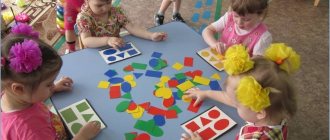Holidays for young children in the family
Zatsepina M. G., Uryadnitskaya N. V.
Holidays are special days in the life of any person, they carry a charge of joy and emotional uplift, promise gifts that are pleasant to every heart and open communication with friends. For a child, holidays and special days are especially significant because they give him new impressions and pleasant excitement, introduce him to traditions, and bring him closer to family and friends. And when he becomes an adult, he remembers with special warmth those childhood holidays that his parents organized for him. Already in the very combination of these two words “children's holiday” there is a specific aroma of home; they are always associated with something very bright and joyful.
Each family develops its own traditions associated with organizing holidays. Some people love it when many guests come and the holiday is celebrated noisily; others prefer quiet holidays with a small circle of family. Such family events are held on the occasion of the birthday of a family member, in connection with such religious and national holidays. like Christmas, Maslenitsa, Easter. In many of them, according to Russian tradition, children can take an active part. These joint activities provide the small child with a variety of experiences and activities: from observation, through imitation and testing his strength, to independent creativity and expression.
In Rus' it was customary to celebrate the day of the Angel, or name day. Birthdays were celebrated modestly. Only for children under seven years of age were they celebrated solemnly. After this age, the day of spiritual birth was given more importance than the day of physical birth. Therefore, name days were celebrated unusually widely. Noble families hosted a magnificent ball with a birthday dinner. On this day, guests came - relatives and friends. During the reception, the youth were in the back rooms, where they had fun and played various games. Not only adults, but also children were preparing for the name day. Such holidays are warmly described by famous writers and poets. So, L.N. Tolstoy in his story “Childhood” tells how with what desire and trepidation birthday gifts were prepared and given: “Karl Ivanovich had a box of his product in his hands, Volodya had a drawing, I had poetry; “Everyone had a greeting on their tongue with which they would present their gift.”
Merchant families often held dance and masquerade balls, and costumed Christmas trees for children. People came to the holiday wearing bright masks and interesting and unusual costumes. The daughter of a Moscow merchant S. Karzinkin recalls that at one of the masquerades her mother appeared dressed as a “basket with violets,” and her daughters were the “flowers.” At the masquerade there was music, games were played, surprises were organized, and everyone danced. Favorite activities were not only preparing for the holidays, but also horse riding, visiting theaters, drawing and evening reading of books and magazines, which were specially subscribed to for children from Moscow and Paris; as well as staging home performances with the participation of adults, solving charades. For older children, there were balls and troika rides. Thus, one of the sisters of the Samara merchant P. Shikhobalov, remembering her first ball, wrote in one of her poems: “...That evening was a fairy tale, amidst the splendor, luxury, flowers...”.
This article will talk about organizing family holidays for the youngest children - up to one year and in the second year of life. Their preparation and implementation require comprehensive knowledge of the characteristics of the child’s mental development, a sensitive attitude to the state of his physical health, only then will the holiday bring him joy and fill him with a feeling of family warmth and comfort.
Baby on family holidays
A child of the first year, naturally, is a “guest” at holidays: he attends them, observes how others behave. The baby's clothes should be beautiful and comfortable - this, on the one hand, will create a solemn mood appropriate for the occasion, and on the other, provide the child with the usual comfort. When planning your child’s participation in family celebrations, you should take into account his interests. This means that, first of all, you need to maintain a daily routine and control the duration of communication with close adults. If you are not sure that you can give your child enough attention, it is better to leave him in a familiar environment, under the supervision of an adult. If you decide to take your baby to the holiday, make sure that he is not capricious or bored and that his impressions of the family feast are pleasant. Adults must be ready to give him enough attention, play with him, using jokes, nursery rhymes, and songs for this: How I wash Lyudochka, I’ll lift him up in my arms, I’ll lift him high, I’ll rock him easily. Yes, I will lower you to the ground, And I will lead you by the hands - Luda will walk with his legs, And he will come to his grandmother.
For a child who is beginning to stand on his feet, you can sing: Top-top, top-top, Here's Andryushenka one year old! Here's to the one-year-old boy, Let's bake Andryusha a pie, Let Andryushenka grow up Healthy and on his way! So much in height (show)! So much wide (show)!
It must be remembered that the child is still very small, physically weak and unable to withstand great emotional stress. He gets tired quickly and gets scared easily, which ultimately leads to overexcitation and whims. Do not pass your baby from hand to hand often. Loud music and voices have a particularly negative impact on children. Therefore, take care of a quiet room where you can go with your baby and play there alone, giving the “little guest” time for rest and peace.
First New Year
This is a special holiday, it remains the most beloved for life. Quite often, parents ask the same question: “Is it possible to decorate a live Christmas tree when the baby is only a few months old or one year old?” The answer is this: if pine needles do not cause allergies in the child, then this can and should be done. Although, to be honest, adults decorate the New Year tree mostly for themselves. Yes, yes, just for yourself: hanging balls and icicles on the branches, you seem to be returning to that bright period of your life when you yourself were little and trembled in anticipation of New Year's Eve. By installing a Christmas tree together with your child, you once again “live” a fabulous holiday.
For children in their first year of life, the New Year tree is a real miracle. They are literally fascinated by shiny balls, fairy-tale characters, cute toys, beautiful firecrackers and sparkling tinsel. A one-year-old baby who is already starting to walk will, of course, try to reach this beauty. Ensure the safety of the child: place the Christmas tree in such a place and at such a level that he cannot reach the toys or accidentally touch them. And then you can decorate a guest from the forest without any restrictions - the same way you would decorate it for yourself.
From a pedagogical point of view, the Christmas tree can be considered a unique tool for developing speech and getting to know the outside world. Small quatrains will help you with this. Start looking at the forest beauty when she is not yet wearing festive decorations and is beautiful in her natural beauty.
Look: our Christmas tree (pay attention to the small needles) has green needles. (Touch them carefully.) If you touch them, they are prickly. (And then touch them with your baby’s fingers.) Smell them - they’re fragrant. (Show me how you inhale the aroma of pine needles.)
Decorate the Christmas tree with your baby, or even better, with the whole family. Give him the opportunity to touch almost everything, which you then hang on the New Year's beauty. Accompany the show with little rhymes: Beautiful, shiny, Sparkles and rustles. With its overflows it makes us happy on holiday.
Let the baby hold the tinsel in his hands, crush it, wave it and rustle it. In the same way, show him a ball, a dog, a snowflake and other safe toys. Having finished with the outfit, walk around the Christmas tree, holding the child in your arms.
Children really love playing with “magic” lights that light up and go out on the Christmas tree.
Here is a row of beautiful lights (run your hand along the garland) - Now they go out, now they are on (let your assistant turn it off and on again). The Christmas trees are shining around (walk around the Christmas tree), Misha (child's name) is invited to the Christmas tree.
Play like this for a while. Don’t miss a favorable opportunity for the child’s development, conduct daily word games: “Find the toy”, “Who is sitting (hiding) on the branch?”
First birthday
If you are organizing a party for the baby himself and he will be at the center of the events, think about the duration of this event. A one-year-old child's participation should be limited to 20-30 minutes. But preparing for the celebration may be a more interesting activity for him. At this age, children already pay attention to beautiful and bright objects, so when preparing for the holiday, start by decorating the room. Hang garlands of light bulbs on the walls (New Year's ones are suitable). Make colorful lanterns from colored paper and hang them so that they can move along a string. You can also cut out birds, flags, bright flowers from thick paper and decorate the room with them. Transform your room into a wonderful fairy-tale world! And now the fun part - look at the festive decorations together with your baby. Let him touch the paper decorations. Blow on them so that they begin to move, let the baby do this with your help and on his own. The rule applies here: the child wants to touch everything he sees, it is necessary to provide him with such an opportunity, to introduce him to new interesting objects and their properties.
At a birthday party, use pestles and songs to create a joyful mood and memorable impressions. Solemnly present the baby with gifts and greet the hero of the day with friendly applause when, with your help, he blows out the first candle in his life on the birthday cake.
Holidays with friends
And now the baby is already in his second year. He has grown up and is able to participate in the holidays more meaningfully. It is understandable that parents would want to invite friends who have children of the same age or slightly older. And such holidays can already be held, but several rules must be followed. For children from 1 to 3 years old they are especially significant, although they apply to all ages.
• The number of people invited to a children's party is no more than three or four children (after all, they will be with their parents).
• The younger the child, the fewer guests.
• All invitees - both children and adults - should be familiar to each other: “strangers” will alert some children, and simply frighten others. This can ruin the holiday or make it completely impossible.
• The duration of the holiday is no more than an hour, the active phase is up to half an hour. At the same time, it is important for the child to act, to participate in events, and not to be a spectator. Children at this age can already dance to a cheerful, playful children's melody, imitating the simple movements of adults, and sing along to a song.
• The holiday script - everything that happens - should be understandable to the children present. You should also alternate active games with quiet activities.
• The treat should be light and short in duration - this is not the main part of the children's party.
• Do not use television as entertainment at a children's party. A short cartoon (5-6 minutes long) can become part of the holiday script, but not its basis.
• Kids love surprises, so it’s good if each child leaves with a gift, even a symbolic one, but the appearance of these gifts should be the same for all children.
New Year's celebration
The New Year's party can now be organized by inviting friends of the same age, which will make it more fun and memorable. The degree of participation of a grown-up child in what is happening is already much greater, so a decorated Christmas tree will certainly become the subject of his close attention and the object of active actions. The selection and placement of Christmas tree decorations should be carried out in a certain way: unbreakable toys (cardboard, cotton, paper, homemade fabric) are placed on the lower branches, and everything that can break, as well as tinsel, rain and garlands - on the upper ones, so that The child could not reach them on his own.
One of the favorite holidays of children is Christmas, which in Russia is celebrated on January 7th. We offer parents an idea that can be used as the basis for a children's Christmas party. You will need: a tape recorder, recordings of dance Russian folk melodies and songs about the New Year tree; white and blue tinsel; rattles, bells and tambourines. Characters: presenter, reading the text “behind the scenes”; Zimushka-Winter (one of the mothers in a hat and fur coat, decorated with white and blue tinsel). A bunny, whose role can be played by an older brother (7-10 years old), or a toy bunny with an elastic band about 1 m long.
Children sit in front of the Christmas tree with their parents. A quiet melody sounds. Zimushka-Winter comes out from behind the Christmas tree, spins around, examines the Christmas tree.
Leading. Winter descended to the earth, brought frosts with it, swept snowdrifts around and lit the Christmas tree in the house.
Imushka-Winter. Here, guys, is the Christmas tree. What an elegant one! The Christmas tree sparkles with bright lights.
Leading. The Sorceress Winter Possesses miracles: Beautiful lights Burn and go out on their own.
Zimushka-Winter Guys, let's play. (Calls the children to the Christmas tree, the parents bring them closer.) We can turn off the lights on the Christmas tree. Watch me do it. (Takes air into his lungs, puffs out his cheeks and blows on the Christmas tree, the assistant turns off the garland - the lights go out.) And now we need to light the lights on our Christmas tree. (Claps his hands, the assistant turns on the garland.) Do you want to learn this trick? Try it, kids, with me. Parents set an example for their children, help them clap their hands, and blow on the Christmas tree together. The game is repeated two or three times, after which the children are seated.
Zimushka-Winter. And under our Christmas tree Zayushka sits and quietly moves his white ears. Come on, little bunny, white little bunny, get out from under the tree!
A bunny jumps out from behind the tree, or Zimushka-Winter pulls out a toy bunny by its rubber band.
Zimushka-Winter. Show your skills, lift our spirits! Jump, dance, show us your dance!
A Russian folk dance melody sounds, Zimushka-Zima dances. The bunny is jumping (the toy bunny is jumping on an elastic band). They invite children to dance, parents and children go out to the Christmas tree, everyone jumps and dances.
Zimushka-Winter. We guys danced, had fun and played. We need to show Bunny how to light a garland!
Everyone once again “plays” with the lights. Now (if technical capabilities allow) children are asked to applaud, which “makes” the lights of the garland blink.
Zimushka-Winter. Oh, guys, I'm so glad: You are so great! And now I’ll dance too, Ring the bells!
He holds out a basket of musical toys. Adults give the kids rattles, bells, tambourines and help them ring in the same rhythm. Zimushka-Winter is dancing. After a couple of minutes, dads sit their children on their shoulders and stand around the Christmas tree. A New Year's melody sounds and a round dance begins. At the end of the holiday, everyone claps their hands - the lights of the garlands blink.
The duration of such a holiday is 15-20 minutes, which is optimal for children of the second year of life. The general rule is to alternate moments of active participation of children with periods when they turn into spectators. Children at this age cannot just watch the twists and turns of the plot for a long time - they want to touch the surrounding objects or just run around. These desires can be harmoniously directed into the general direction of the holiday, then it will go smoothly and interestingly. Include “interactive” episodes in your script when kids become, for example, bunnies and jump with the bunny or snowflakes, and spin with the main snowflake - their mother. Also, put small toys (rattles, snowballs, bells, flags) under the Christmas tree, and at the right moment, hand them out to the children and show them simple and unpretentious movements. By repeating them, kids will be able to jump and frolic.
Have you noticed that there is no Santa Claus in the proposed scenario? And this is no coincidence: children even in the second year of life, especially up to one and a half years old (for whom the figure of Santa Claus is not at all important for the holiday), can be frightened by a character of such an unusual appearance. Therefore, you should not invite him to a children's party. If you think that without Santa Claus, the New Year’s celebration will not be complete, then let a familiar adult play this role. Putting on a suit should take place in the presence of children: if, after putting on a fur coat (caftan), none of the kids cried, you can move on to a hat and mittens. At the same time, do not try to exactly repeat the makeup that everyone knows - a beard, thick eyebrows from under a hat and bright blush.
All adults who come to the holiday must take part in what is happening: repeat the dance movements shown by the presenter, play the proposed games with the children. If a round dance is started around the Christmas tree, then a special role is given to dads, on whose shoulders the children will “perform” it. Only with such an organization of the New Year's holiday will each child receive the impressions, skills and even knowledge for which the adults organized this holiday.
Birthday
The parents celebrated the first anniversary of their pet mostly for themselves; the little boy, who did not understand anything, sat on his mother’s lap and looked around. Two-year-old children already perceive this holiday quite consciously, and they can and should be prepared for it. It is necessary to clearly and clearly explain to the child what happened on this day, why it is so important for the adults around and loving him, why other children, along with their parents, will come to congratulate him. A mandatory attribute of the holiday should be a cake or sweet pie with two candles. At the birthday party, arrange a dance for the children so that they can frolic to some rhythmic tune. At the same time, be sure to show them dance movements (it is better if several adults participate in the children’s dance), encourage clapping, stamping, twirling, etc., which are accessible to children of this age, offer to jump like a bunny, wave their “wings” like birds. Show how a dog wags its tail, how a clumsy bear waddles from foot to foot, etc.
You can organize a theater. Children of the second year of life understand a plot in which no more than two or three characters are recognizable and familiar to them. It could be a bear, a cat, a girl, or the sun. Do not neglect the productions of fairy tales already known to your child, which you read to him: “Mashenka and the Bear”, “The Ringed Hen” (and for older children - “Turnip”, “Kolobok”). They are understandable to the baby, although there are slightly more characters in them. In addition, here you can improvise, but in such a way as not to confuse little viewers and not disrupt the storyline. This will enliven the familiar plot and enrich the characters’ characters. Avoid long monologues, give the action dynamism. Come up with your own stories consisting of two to four episodes - visual and spectacular.
It is good if among the audience there are adults who will react vividly to what is happening on stage - laugh, clap their hands, respond to the remarks of the characters in the play addressed to the audience. This example will show children how to behave when watching a performance and enjoy it.
Organizing a home theater is a very exciting, interesting activity and leisure activity not only for children, but also for parents. Of course, this is quite difficult and troublesome, but the results justify the time and energy spent. When organizing a performance, you can use rubber or soft toys available in the house. In addition, you can make figures of the characters from the play from cardboard. The main thing is that toys must be selected in size. You can use a table or a large box as a stage. For a screen, a structure made of two chairs covered with fabric, or an open suitcase, the lid of which is decorated in accordance with the content of the performance, is suitable. It is better to make the decoration from cubes, and cut out trees, flowers and other elements from paper. The characters of the play must come out and move from the depths of the stage towards the audience. Imitation of movement is achieved by swaying from side to side or jumping. When it is necessary to portray the hero of the play as sleeping, he is turned with his back to the children. If a character in a fairy tale speaks, then the doll should be moved slightly and left motionless if he listens.
At the end of the performance, bows of the artists and greetings by the audience are required. Maybe someone “from the audience” will present the performers with flowers, which need to be prepared in advance, explaining to the kids the meaning of this action.
There are several more recommendations related to the age characteristics of children. So, kids need to be prepared for the performance: introduced to the main characters, shown, named and allowed to touch the figures of the characters and decorations. Such preliminary acquaintance is necessary so that during the course of the action the child does not have the desire to take some attribute of the performance design into his hands. Only after this can you place on the table (box) all the props necessary to start the performance.
You can involve older children in participating in the performance, but in this case the child only acts with the toy, and the text of the character in the fairy tale or the words of the song are pronounced by the adult. Involving older siblings in a home theater production makes the performance truly a family activity. When a holiday is celebrated in a family, it has its own peculiarity, which lies in the presence of improvisation, the desire to make sure that everyone feels at home and has fun. Everything should come from the heart.
In a short article it is impossible to talk about all the traditional holidays that can be celebrated with a young child in the family. Therefore, parents can use manuals for kindergarten teachers with methodological recommendations for holding holidays with the participation of children.
Magazine "Preschool Education" No. 1, 2005
Family leisure with young children
Kyle Pruett, a professor at the Center for Child Studies at Yale University, notes that babies react differently to their parents. In the presence of his mother, he relaxes, awaits gentle treatment, gentle hugs, and affection. Meeting his father excites and stimulates him. He expects unusual games from his father, and he, in turn, is forced to maintain a high bar of childhood aspirations. However, when the little one manages to get his dad’s undivided use, both are happy. K. Pruett states: “Even in cases where the main nanny, due to some circumstances, is the father, he does not become the mother.”
Fathers tend to give more space to the child’s personality and more often let him out of sight, giving him freedom. Mothers, on the contrary, follow on the heels of the little one. When a child approaches something dangerous (from her point of view), she instinctively appears nearby, as if asserting that the baby is under her protection. As soon as he decided to climb onto the sofa, she was already there, ready to help. Often, seeing the tension in the mother’s posture, movements, fear in her eyes, the child refuses independent attempts to test his own capabilities.
Excessive caution, excessive willingness to help in everything, fear that the little one will certainly harm himself without her care, lack of patience, and sometimes even time - this is a small list of common mistakes of loving mothers. And the baby needs to be supported, trusted, and instilled with faith in his own strength. He longs to demonstrate to his household his skill, dexterity, and courage. This is greatly facilitated by playing with dad. The father prefers not to interfere, seeing his baby stuck in a box among toys, giving him the opportunity to cope with the situation himself, to gain his own experience, even if not always successful. He stoically treats his pet’s bumps and bruises, with approving statements and friendly pats he allows the naughty girl to feel “on an equal footing” with him.
In outdoor games, mother tends to use toys and accompany the game with poetry and singing. Dad prefers to use his hands, his own body as an ideal gymnastic apparatus. Men like to bring something new and unusual to any game every time.
The kid doesn’t know what will happen in the game in the next moment, or how dad will behave. This is what he comes to adore about men's games. They keep the mischievous person in a state of psychological tension. He squeals with delight, either flying up in his dad's strong arms, or dropping down to touch his adored dad's nose with his nose. But he doesn’t let up, turns the baby from side to side, lowers him onto the carpet, now to his right, now to his left, now growls, now purrs peacefully. Dad himself absolutely loves it when this irrepressible creature puffs, climbs over him, jumps up, straddling him, or stretches along his body, looking with enthusiastic little eyes into the eyes of his beloved parent, with all his appearance inviting him to extend the game.
And now the baby, with fear and delight or with laughter, tries to stay on his swaying foot, not even trying to predict whether he will fly up onto his father’s chest, or end up sitting on the carpet. And so every time surprise after surprise. Just some 10-15 minutes, completely given over to having fun together, but so many deep, vivid memories for many years. The baby vitally needs both the gentle, affectionate touches of his mother and manly games with his father. This is one of the secrets of the baby’s heartfelt closeness to each of them.
Outdoor games allow the child to discover his own capabilities of independence, dexterity, and courage. By the age of two, a child begins to show himself as an actively developing personality; he develops a strong positive position in relation to the world of people, to the world of objects and to himself.
The little one will always be happy to keep you in excellent company in a variety of outdoor games.
Introduction
The main goal of holidays, matinees and entertainment organized in preschool institutions is to bring joy to children. Holidays must be accompanied by good music, new decoration of the hall, an interesting story game, and various surprises. The decoration of the hall is done taking into account the season, beautifully, tastefully, according to the plot of the festive game. Children's costumes should be comfortable, beautiful and interesting.
Young children are not yet able to perceive the idea of holidays, but they are attracted by the unusualness and colorfulness of the action taking place. Holidays should be unusual and joyful for kids. The basis of a children's holiday is a game. It should be noted that meetings with fairy-tale characters at the holiday bring joy to children.
The musical material included in the scripts for holiday matinees corresponds to the level of musical development of children and their capabilities. Some spectacular episodes of a festive matinee can be part of the entertainment. Holidays are held throughout the year in autumn, winter (New Year's matinees) and spring, and various leisure activities are also held once or twice a month.
The construction of matinees for young children is unique. Only well-known musical material is used: songs, musical-motor displays, dances and games.
In an early age group, the role of adults at the holiday is especially important. Alternating spectacular moments with active actions of children will help teachers give children pleasure and joy. Movement to cheerful, lively music delights children. It is necessary to stimulate and support the independence and activity of children in musical games, exercises, and dances.
Teach children to perform play and dance movements to the music that correspond to the words of the song and the nature of the music. Try to be attentive and patient with kids, strive to develop their emotional responsiveness to music.
We wish you success!
Junior group. Early childhood, nursery. Children 1-4 years old
Scenario for the New Year holiday for children from 2 to 3 years old Scenario for the New Year (for children from 2 to 3 years old)
(children enter the hall to the music and sit by the tree)
Snow Maiden: Oh, what a tree in the hall. We have never seen anything like this. The dress is covered in needles, lanterns, and toys. The lights sparkle on her, from below to the top of her head. Let's hold hands...
Scenario of a matinee for children 3–4 years old “We welcome the New Year” WE CELEBRATE THE NEW YEAR. 2nd junior group Children with a teacher enter the hall, freely stand in front of the Christmas tree, look at the decorated Christmas tree. Presenter: Having spread its needles, the Christmas tree shines with beauty. There are so many balls, toys, cones, stars, firecrackers here. We need to look at the tree, we’ll stand in...





